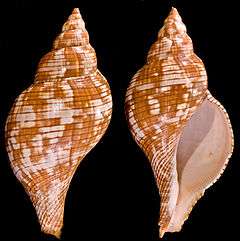Fasciolariidae
| Fasciolariidae | |
|---|---|
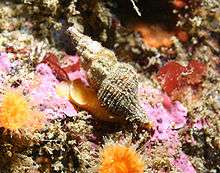 | |
| A live image of Fusinus monksae | |
| Scientific classification | |
| Kingdom: | Animalia |
| Phylum: | Mollusca |
| Class: | Gastropoda |
| (unranked): | clade Caenogastropoda clade Hypsogastropoda |
| Superfamily: | Buccinoidea |
| Family: | Fasciolariidae Gray, 1853 |
| Type genus | |
| Fasciolaria, Lamarck, 1799 | |
| Genera | |
|
See text | |
The Fasciolariidae, common name the "tulip snails and spindle snails", are a family of small to large sea snails, marine gastropod mollusks in the superfamily Buccinoidea.
The family Fasciolariidae probably appeared about 110 million years ago during the Cretaceous [1]
Distribution
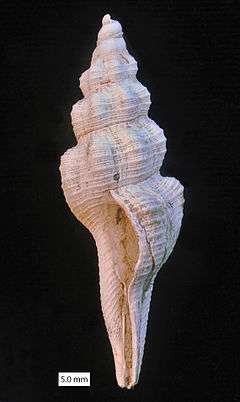
The recent species inhabit tropical to temperate waters.
Description
The shells are usually reddish in color and have a moderate to large size, reaching a height between 1.0 and 60 cm. The shells are spindle-shaped and biconic. The spire is elongated. The siphonal canal is well developed and is long to moderately long. The columella varies between a smooth appearance and showing spiral folds. The horny operculum has an oval shape. Their radula is characteristic with narrow central teeth with three cusps. The wide lateral teeth show numerous ctenoid (= comblike) cusps.
Snails in the family Fasciolariidae are carnivorous. They feed on other gastropods and on bivalves. Some also prey on worms and barnacles.
The snails are gonochoristic, i.e. the individuals have just one sex. The female snails deposit their eggs in horny capsules either in a single form or in clusters arranged around a hollow axis. The single forms have a flattened, disk-shaped, or vase-shaped form. The clusters are hemispherical or cylindrical. Development is usually direct. The larvae emerge from the capsules as free-swimming young or as crawling young.[1]
Taxonomy
According to the taxonomy of the Gastropoda by Bouchet & Rocroi (2005), the Fasciolariidae consist of three subfamilies:
- Fasciolariinae Gray, 1853
- Fusininae Wrigley, 1927 - synonyms: Fusinae Swainson, 1840 (inv.); Cyrtulidae MacDonald, 1869; Streptochetinae Cossmann, 1901
- Peristerniinae Tryon, 1880 - synonym: Latiridae Iredale, 1929
Genera
Genera in the family Fasciolariidae include (fossil genera are marked with a dagger):[2][3]
- subfamily Fasciolariinae
- Fasciolaria Lamarck, 1799 - type genus, the Tulip shells
- Africolaria Snyder, Vermeij & Lyons, 2012
- Aurantilaria Snyder, Vermeij & Lyons, 2012
- Australaria Snyder, Vermeij & Lyons, 2012
- Bellifusus Stephenson, 1941 †
- Boltenella Wade, 1917 †
- Brucia Cossmann, 1920 †
- Calkota Squires & Saul, 2003
- Cinctura Hollister, 1957
- Conradconfusus Snyder, 2002 †
- Cryptorhytis Meek, 1876 †
- Drilliovoluta Cossmann, 1925 †
- Drilluta Wade, 1916 †
- Filifusus Snyder, Vermeij & Lyons, 2012
- Granolaria Snyder, Vermeij & Lyons, 2012
- Haplovoluta Wade, 1918 †
- Hercorhyncus Conrad, 1869 †
- Hylus Wade, 1917 †
- Kilburnia Snyder, Vermeij & Lyons, 2012
- Liochlamys Dall, 1889 †
- Lirofusus Conrad, 1865 †
- Lugubrilaria Snyder, Vermeij & Lyons, 2012
- Mariafusus Petuch, 1988 †
- Micasarcina Squires & Saul, 2003 †
- Microcolus Cotton & Godfrey, 1932
- Microfulgur Finlay & Marwick, 1937
- Mylecoma Squires & Saul, 2003 †
- Odontofusus Whitfield, 1892 †
- Paleopsephaea Wade, 1926 †
- Parafusus Wade, 1918 †
- Perse B.L. Clark, 1918 †
- Piestochilus Meek, 1864 †
- Plectocion Stewart, 1927 †
- Pleia Finlay, 1930
- Pleuroploca P. Fischer, 1884
- Pliculofusus Snyder, Vermeij & Lyons, 2012 †
- Saginafusus Iredale, 1931
- Scobina Wade, 1917 †
- Serrifusus Meek, 1876 †
- Skyles Saul & Popenoe, 1993 †
- Terebraspira Conrad, 1862 †
- Trichifusus Bandel, 2000 †
- Triplofusus Olsson & Harbison, 1953
- Wadia Cossmann, 1920 †
- Whitneyella Stewart, 1927 †
- Woodsella Wade, 1926 †
- subfamily Fusininae
- Fusus Bruguière, 1789 : synonym of Fusinus Rafinesque, 1815
- Africolithes Eames, 1957 †
- Amiantofusus Fraussen, Kantor & Hadorn, 2007
- Austrolithes Finlay, 1931 †
- Chiralithes Olsson, 1930 †
- Chryseofusus Hadorn & Fraussen, 2003
- Clavellofusus Grabau, 1904 †
- Clavilithes Swainson, 1840 †
- Cosmolithes Grabau, 1904 †
- Cyrtulus Hinds, 1843 - Cyrtulus serotinus Hinds, 1843
- Falsicolus Finlay, 1930
- Falsifusus Grabau, 1904 †
- Fredenia Cadée & Janssen, 1994 †
- Fusinus Rafinesque, 1815 - type genus of the subfamily Fusininae
- Gemmocolus Maxwell, 1992 †
- Granulifusus Kuroda & Habe, 1954
- Harasewychia Petuch, 1987
- Helolithus Agassiz, 1846 †
- Lepidocolus Maxwell, 1992 †
- Liracolus Maxwell, 1992 †
- Mancorus Olsson, 1931 †
- Ollaphon Iredale, 1929
- Perulithes Olsson, 1930 †
- Priscofusus Conrad, 1865 †
- Profusinus Bandel, 2000 †
- Pseudaptyxis Petuch, 1988 †
- Pullincola de Gregorio, 1894 †
- Remera Stephenson, 1941 †
- Rhopalithes Grabau, 1904 †
- Simplicifusus Kira, 1972
- Solutofusus Pritchard, 1898 †
- Spirilla Agassiz, 1842 †
- Streptocarina Hinsch, 1977 †
- Streptochetus Cossmann, 1889 †
- Streptodictyon Tembrock, 1961 †
- Streptolathyrus Cossmann, 1901 †
- Tectifusus Tate, 1893 †
- Trophonofusus Kuroda & Habe, 1971
- Turrispira Conrad, 1866 †
- Viridifusus Snyder, Vermeij & Lyons, 2012
- subfamily Peristerniinae
- Peristernia Mörch, 1852 - type genus of the subfamily Peristerniinae
- Aptycholathyrus Cossman & Pissarro, 1905 †
- Ascolatirus Bellardi, 1884 †
- Benimakia Habe, 1958
- Brocchitas Finlay, 1927 †
- Bullockus Lyons & Snyder, 2008
- Dennantia Tate, 1888 †
- Dentifusus Vermeij & Rosenberg, 2003
- Dolicholatirus Bellardi, 1886
- Eolatirus Bellardi, 1884 †
- Exilifusus Conrad, 1865 †
- Fractolatirus Iredale, 1936
- Fusolatirus Kuroda & Habe, 1971
- Hemipolygona Rovereto, 1899
- Lathyropsis Oostingh, 1939 †
- Latirofusus Cossmann, 1889
- Latirogona Laws, 1944 †
- Latirolagena Harris, 1897
- Latirulus Cossmann, 1889
- Latirus Montfort, 1810
- Leucozonia Gray, 1847
- Lightbournus Lyons & Snyder, 2008
- Liochlamys Dall, 1889 †
- Mazzalina Conrad, 1960 †
- Neolatirus Bellardi, 1884 †
- Nodopelagia Hedley, 1915
- Opeatostoma Berry, 1958
- Plesiolatirus Bellardi, 1884 †
- Plicatella Swainson, 1840
- Polygona Schumacher, 1817
- Psammostoma Vermeij & Snyder, 2002 †
- Pseudolatirus Bellardi, 1884[4]
- Pustulatirus Vermeij & Snyder, 2006
- Ruscula Casey, 1904 †
- Streptopelma Cossmann, 1901 †
- Tarantinaea Monterosato, 1917
- Taron Hutton, 1883
- Teralatirus Coomans, 1965
- Turrilatirus Vermeij & M.A. Snyder, 2006
- Subfamily ?
- Crassibougia Stahlschmidt & Fraussen, 2012
- Aquilofusus semiglaber
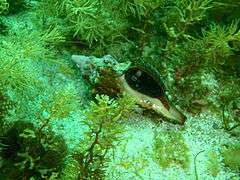
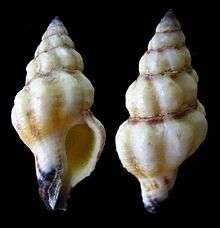

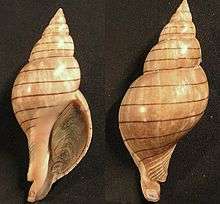
- Clavilithes laevigatus

- Euthriofusus burdigalensis
- Fasciolaria scalarina
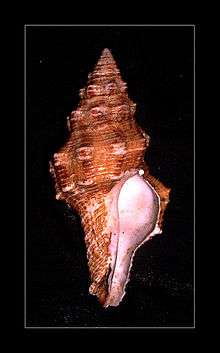
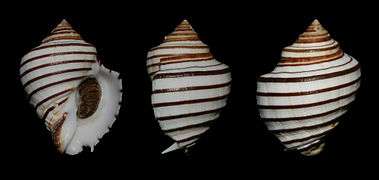
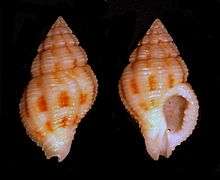
- Pseudolatirus kuroseanus
- Genera brought into synonymy
- Aptyxis Troschel, 1868: synonym of Fusinus Rafinesque, 1815
- Barbarofusus Grabau & Shimer, 1909: synonym of Fusinus Rafinesque, 1815
- Buccinofusus Conrad, 1868: synonym of Conradconfusus Snyder, 2002 †
- Bulbifusus Conrad, 1865 †: synonym of Mazzalina Conrad, 1960 †
- Chasca Clench & Aguayo, 1941: synonym of Chascax Watson, 1873: synonym of Hemipolygona Rovereto, 1899
- Chascax Watson, 1873: synonym of Hemipolygona Rovereto, 1899
- Cinctura Hollister, 1957: synonym of Fasciolaria Lamarck, 1799
- Clavella Swainson, 1835: synonym of Clavilithes Swainson, 1840 †
- Cymatium Link, 1807: synonym of Latirus Montfort, 1810
- Exilifusus Gabb, 1876 †: synonym of Fusinus Rafinesque, 1815
- Fusilatirus McGinty, 1955: synonym of Dolicholatirus Bellardi, 1884
- Fusus Bruguière, 1789: synonym of Fusinus Rafinesque, 1815
- Gracilipurpura Jousseaume, 1881 †: synonym of Fusinus Rafinesque, 1815
- Harfordia Dall, 1921: synonym of Fusinus Rafinesque, 1815
- Heilprinia Grabau, 1904: synonym of Fusinus Rafinesque, 1815
- Iaeranea Rafinesque, 1815: synonym of Fasciolaria Lamarck, 1799
- Lagena Schumacher, 1817: synonym of Latirolagena Harris, 1897
- Lathyrus Schinz, 1825: synonym of Latirus Montfort, 1810
- Latirofusus Cossmann, 1889: synonym of Dolicholatirus Bellardi, 1884
- Latyrus Carpenter, 1857: synonym of Latirus Montfort, 1810
- Propefusus Iredale, 1924: synonym of Fusinus Rafinesque, 1815
- Pseudofusus Monterosato, 1884: synonym of Fusinus Rafinesque, 1815
- Pseudolatirus Cossmann, 1889 †: synonym of Streptolathyrus Cossmann, 1901 †
- Simplicifusus Kira, 1972: synonym of Granulifusus Kuroda & Habe, 1954
- Sinistralia H. Adams & A. Adams, 1853: synonym of Fusinus Rafinesque, 1815
- Tarantinaea Monterosato, 1917: synonym of Fasciolaria Lamarck, 1799
References
- 1 2 Snyder M.A. "Catalogue of the marine gastropod family Fasciolariidae". Academy of Natural Sciences. Retrieved 2010-08-08.
- ↑ "Fasciolariidae". Integrated Taxonomic Information System.
- ↑ WoRMS : Fasciolariidae
- ↑ WoRMS (2010). Pseudolatirus Bellardi, 1884. In: Bouchet, P.; Gofas, S.; Rosenberg, G. (2010) World Marine Mollusca database. Accessed through: World Register of Marine Species at http://www.marinespecies.org/aphia.php?p=taxdetails&id=446090 on 2010-08-01
External links
| Wikispecies has information related to: Fasciolariidae |
| Wikimedia Commons has media related to Fasciolariidae. |
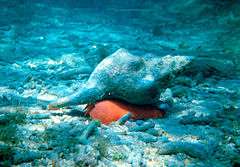
.jpg)
